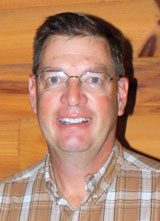 Reggie Terry has lived on a farm all his life. His dad was a dairy farmer, but Reggie didn’t go into that. Around 1984, he started buying and raising bottle calves. He came across some crossbred heifers and decided to start a beef cow herd.
Reggie Terry has lived on a farm all his life. His dad was a dairy farmer, but Reggie didn’t go into that. Around 1984, he started buying and raising bottle calves. He came across some crossbred heifers and decided to start a beef cow herd.
He owns 70 acres of the farm where he grew up, and in 1996 he and his wife, Rachel, purchased a 40-acre farm about four miles from it in Webster County near Niangua, Mo. He rents another 100 acres near his home.
Reggie called his farm, “a hobby farm that’s about got out of control.” He has a cow/calf operation. Currently he has 22 cows, eight heifers, three bulls and 14 calves. His cattle are mostly Angus and Angus cross. Reggie stated, “When I started out, I had five little crossbred heifers; bottle calves. I think two or three of them were Limousin/Holstein cross and the others were Hereford/Holstein cross. They were all black, so I just stayed with black.”
Reggie grows his own mixed grass hay and said 99 percent of the time he has enough to carry his herd through
the winter.
In 2012 we had the drought but 2013 brought plenty of rain and farmers baled lots of hay. However, Reggie stated, “The wet year was worse quality. I had more hay, but less quality.” He believes too much rain has a negative impact on the nutritional value of the hay. “I think it just grows too fast and you get more stem than you do anything.”
He added, “I’ve got one field that has that wild lespedeza stuff in it and it’s just getting thicker and thicker. The cattle are getting to where they won’t hardly eat it. It’s real tall and looks pretty; nice and green. But they say it has no nutrition to it, and cows don’t like it very well either.”
Because of the previous drought, many farmers baled everything they could last summer. Some may have hay to carry over to next winter. When it comes to the loss of nutritional value, Reggie said, “I’ve always been told that it loses 90 percent of what it’s going to lose the first year. That was back with square bales. They always said that once you put them in the barn, the first year they’re going to lose 90 percent. The hay will be the same after the first year as it will be five years later. Whether that’s right, I’m not sure.”
Reggie doesn’t really have to worry because he carries very little over from one year to the next.
When it comes to netwrapping the hay Reggie stated, “I’d say it saves a little bit of hay, but I don’t see that it’s that big of a benefit.” Whether or not his hay is wrapped depends on who he has bale it.
While it might save a little hay, Reggie said, “It’s a pain to get it off when there’s ice on. It freezes to it and you can’t cut it. You can’t get it pulled loose. Whatever hay is frozen there sticks to the netwrap. It’ll tear two or three inches of hay with it when it comes off, when it’s frozen.”
As far as supplements, Reggie keeps mineral tubs out for the cattle year round. He said, “I don’t grain them very often. Once a week I’ll give them some just so they’ll come up and I can work them if I need to. If I have one that won’t come up and won’t go in the corral, she goes to town.”
Temperament of cattle is very important to Reggie. A friend asked why he raised all his heifers and kept them instead of selling them for a high price and buying cows ready to calve. Reggie told him, “This way I know what I’ve got. Every cow I have was born on our farm.”
He didn’t buy any bottle calves last year, but said, “I may try to buy some in March because I like messing with them.”
He prefers to buy calves in cold weather. Reggie said, “You don’t have to deal with the flies and I think they do better in cold weather than they do hot.”
Reggie commented, “I usually have better luck selling Holstein steers at about 400 pounds.”
His biggest concern with cattle in winter is calving. He said, “Most of my calving is in November and then February and March. Those little Black Angus calves, if they get up and suck momma, I don’t think it gets cold enough to hurt them. They’ll be out running, bucking and kicking in zero just like it’s a sunny day and 80.”
The goal Reggie has for his farm is “to have 30 momma cows.” He said, “With the cows I have now and the heifers I have coming on, that’ll put me at 30. I’ll just kind of see how that works out; if I have enough land to run that many.”







